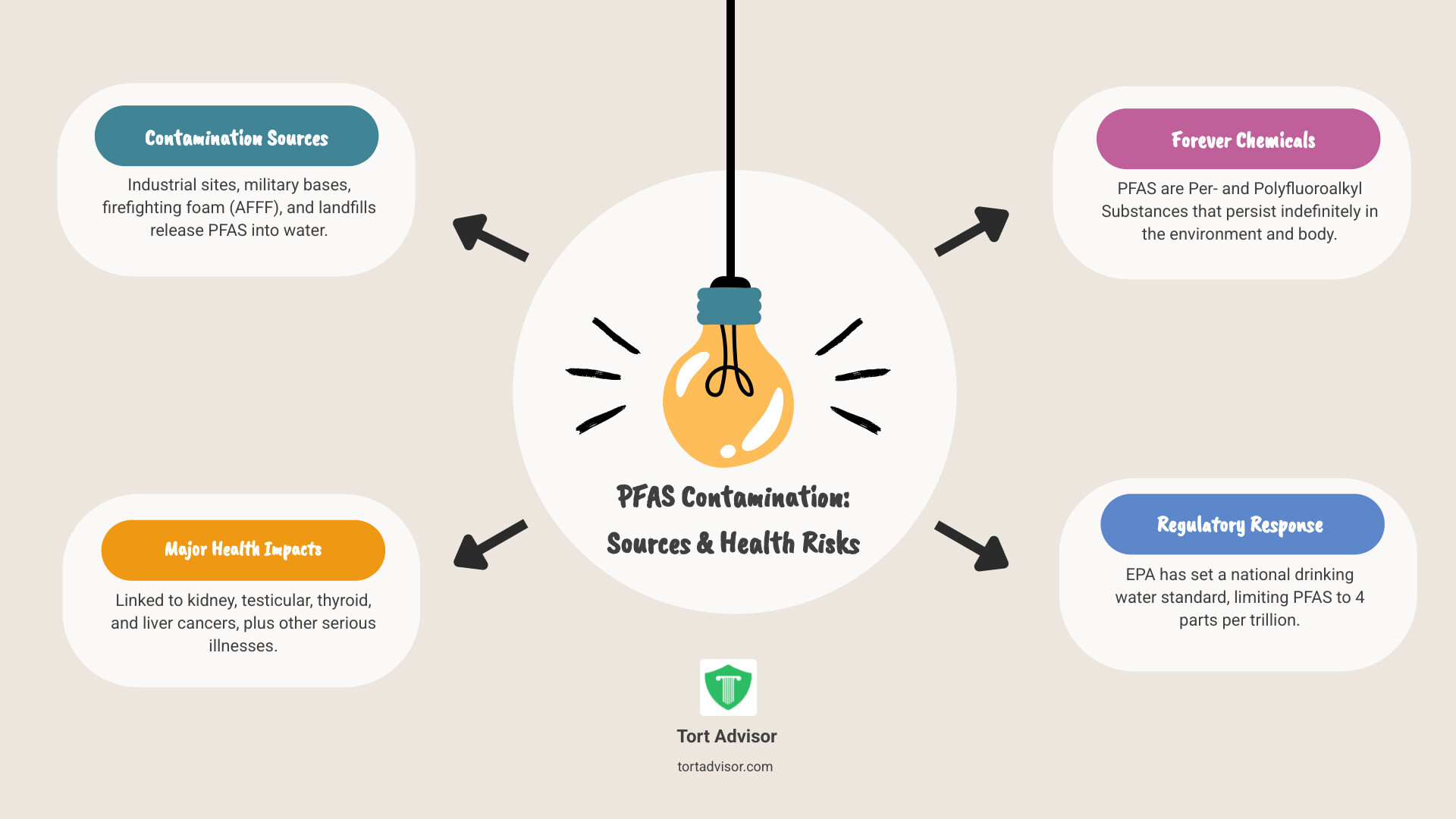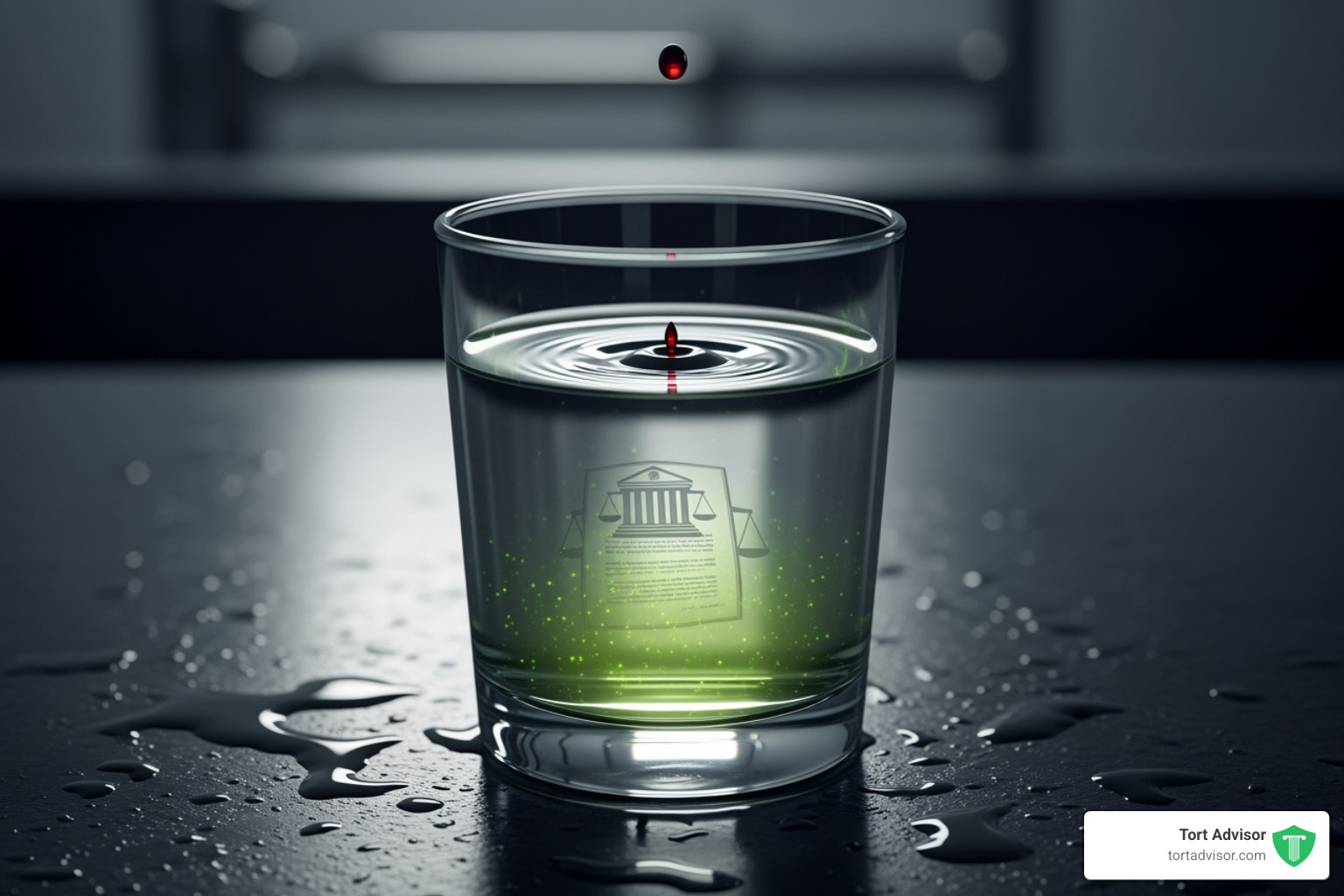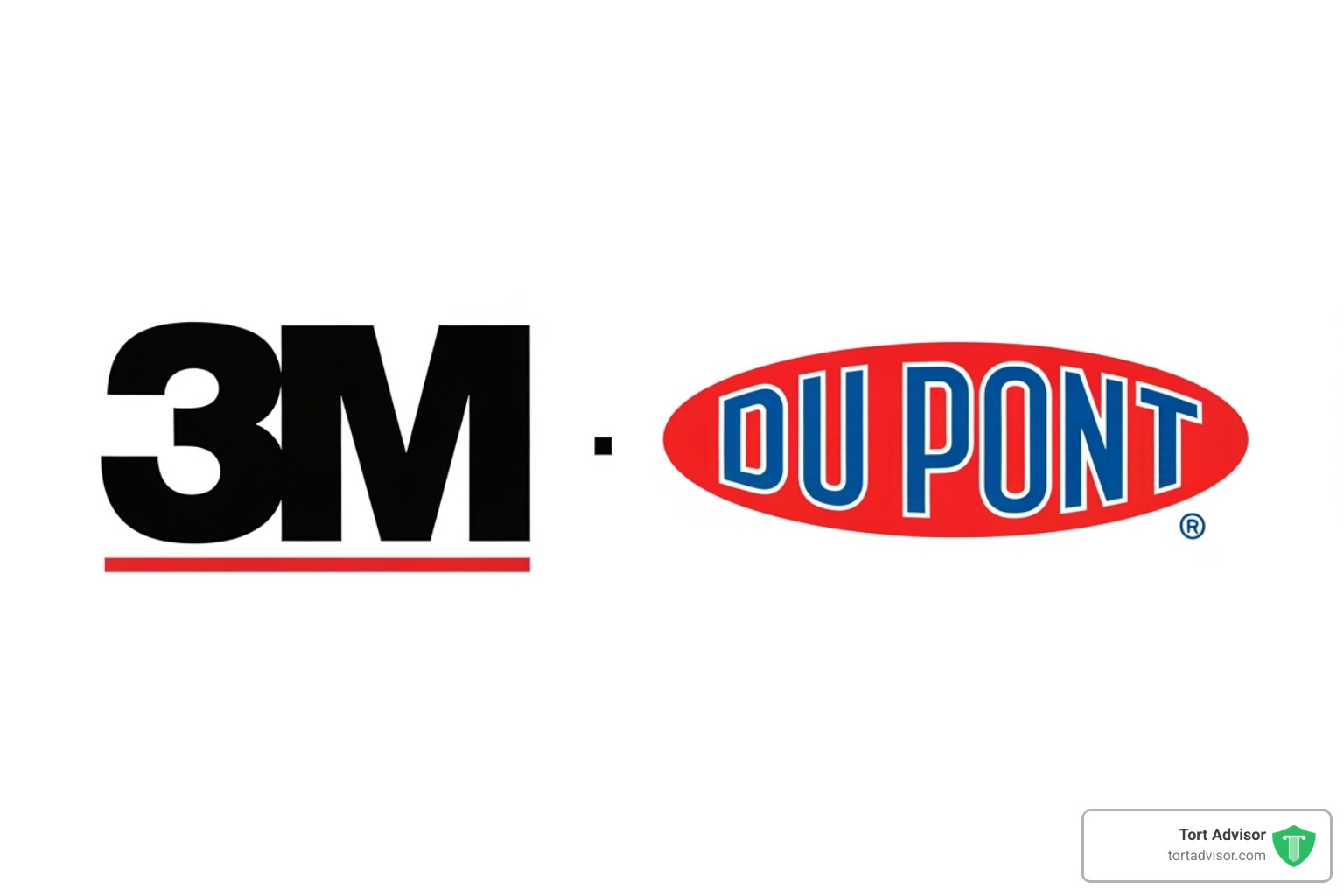


Understanding the PFAS Water Contamination Crisis
A pfas cancer water contamination lawsuit represents a major environmental health crisis. These cases involve people who developed cancer after drinking water contaminated with toxic “forever chemicals” called PFAS.
Key Facts About PFAS Cancer Water Contamination Lawsuits:
- Who can file: People diagnosed with kidney, testicular, liver, or thyroid cancer after PFAS exposure
- Settlement range: $175,000 to $350,000 per person on average
- Major defendants: 3M, DuPont, Chemours, Tyco Fire Products
- Total settlements reached: Over $12 billion as of 2025
- Affected Americans: At least 45% of U.S. tap water contains PFAS
- No upfront costs: Attorneys work on contingency fee basis
PFAS (per- and polyfluoroalkyl substances) are synthetic chemicals that don’t break down naturally, contaminating drinking water across all 50 states through industrial waste and firefighting foam.
Research links these chemicals to serious health problems like kidney cancer, testicular cancer, and thyroid disease. The EPA now limits PFAS in drinking water to 4 parts per trillion.
Thousands of lawsuits are pending against manufacturers who knew about PFAS dangers but continued production. Major settlements are being paid to affected communities and individuals.
My name is Mason Arnao. My experience with legal data management systems for mass tort litigation, including pfas cancer water contamination lawsuit cases, gives me a unique insight into how these complex cases are built and resolved.
Understanding PFAS ‘Forever Chemicals’ and Their Health Risks
If you’re considering a pfas cancer water contamination lawsuit, it helps to understand exactly what these dangerous chemicals are and how they’re affecting millions of Americans. The story of PFAS is one of innovation gone wrong and the serious health consequences we’re all paying for.
What Are PFAS and Why Are They Called ‘Forever Chemicals’?
PFAS stands for per- and polyfluoroalkyl substances, a class of over 12,000 human-made chemicals developed in the 1940s. Their resistance to heat, water, and oil made them perfect for countless products, including non-stick pans, waterproof jackets, and food containers.
The nickname “forever chemicals” comes from their incredibly strong carbon-fluorine bond. This bond prevents PFAS from breaking down naturally in the environment or in your body, causing them to build up over time.
The two most common and studied types are PFOA (perfluorooctanoic acid) and PFOS (perfluorooctane sulfonic acid). Our current understanding of PFAS health risks continues to grow as researchers learn more.
How PFAS Contaminates Drinking Water
Understanding how PFAS gets into our drinking water is crucial for a pfas cancer water contamination lawsuit. These chemicals travel far from where they started and can show up in unexpected places.
Industrial sites are major culprits, releasing PFAS into the air and water. Landfills are another source, as products containing PFAS break down and seep into groundwater.
A primary source has been Aqueous Film-Forming Foam (AFFF). This firefighting foam, loaded with PFAS, was used for decades by military bases and airports in training and emergencies, dumping massive amounts of PFAS into the ground.
The military planned to stop using AFFF in 2024, but the damage was done. Hundreds of military bases now have contaminated water, which often spreads to nearby communities and drinking wells.
Once PFAS gets into soil or surface water, it travels to groundwater systems that supply drinking water to millions of Americans. The numbers are staggering – at least 45% of U.S. tap water contains PFAS. As of May 2024, over 6,000 sites in all 50 states have confirmed PFAS contamination.
The Link Between PFAS Exposure and Cancer
Because your body can’t break down PFAS, these chemicals build up in your system over years. This bioaccumulation is why pfas cancer water contamination lawsuit cases are so important—people have been unknowingly poisoned through their drinking water.
The research on PFAS and cancer is now overwhelming. Kidney cancer shows some of the strongest links. Studies have found significantly higher cancer rates in people with high PFAS levels in their blood.
Testicular cancer is another major concern. Research has shown increased risks among groups with heavy PFAS exposure, including Air Force personnel who worked around AFFF.
PFAS also disrupts your hormone system, which explains the connection to thyroid cancer and thyroid disease. PFAS interference can lead to both cancer and other serious thyroid problems.
Liver cancer is increasingly linked to PFAS exposure. These chemicals can damage your liver over time, potentially leading to cancer. Beyond cancer, PFAS exposure is connected to ulcerative colitis, reduced immune function, high cholesterol, and fertility issues.
Scientists are also investigating links between PFAS and prostate, breast, and pancreatic cancers. The full scope of health conditions linked to PFAS is still being uncovered, but what we know already is deeply concerning.
The EPA’s Role: New Regulations and Health Advisories
The government is finally taking PFAS seriously, which strengthens the case for anyone pursuing a pfas cancer water contamination lawsuit. The EPA has moved from voluntary guidelines to legally enforceable limits.
In April 2024, the EPA announced the first national standard for PFAS in drinking water. The new enforceable limits are incredibly strict—just 4 parts per trillion (ppt) for both PFOA and PFOS.
This is a huge change from the old 2016 health advisory of 70 ppt, which was not legally binding. Now, water systems must test for PFAS and take action if levels are too high.
The Bipartisan Infrastructure Law has made $21 billion available for PFAS cleanup, including money for testing, treatment technology, and upgrading water systems.
These new regulations and funding commitments are game-changers. They officially recognize that PFAS contamination is a national crisis requiring immediate action, which provides strong support for legal claims against the companies that created this mess.
The Landscape of a PFAS Cancer Water Contamination Lawsuit
If you’re dealing with cancer or other health issues after drinking contaminated water, you’re not alone. The legal landscape for a pfas cancer water contamination lawsuit is complex, but understanding it can help you make informed decisions. Thousands of people have filed successful claims, and major settlements are being reached, showing that these corporations can be held accountable.
Who Is Eligible to File a PFAS Lawsuit?
To file a pfas cancer water contamination lawsuit, you generally need two things: significant exposure to contaminated water and a health condition linked to that exposure.
If you consumed PFAS-contaminated drinking water for at least six months (total time) from 1990 to the present, you may have a strong claim. The exposure period is important because these chemicals build up in your body over time.
The health conditions most commonly seen in successful lawsuits include kidney cancer, testicular cancer, thyroid cancer, liver cancer, and ulcerative colitis. Your diagnosis typically needs to have occurred in 2000 or later to qualify.
Certain groups face higher risks and often have strong cases. Firefighters and military personnel were exposed to massive amounts of PFAS through firefighting foam used in training and emergencies.
Residents living near contaminated areas also frequently qualify. This includes people near military bases, airports, industrial facilities, or landfills where PFAS chemicals were used or disposed of.
Property owners face a different situation. Even without a personal health diagnosis, you might have grounds for a lawsuit if PFAS contaminated your property, decreased its value, or required expensive remediation work.
Here’s something important to know: many people never received direct notice from their water supplier about PFAS contamination. Don’t assume your water was safe just because you weren’t warned. The contamination was often finded years after exposure occurred.
Major Companies and States Involved in Litigation
When you file a pfas cancer water contamination lawsuit, you’re typically going up against the large chemical manufacturers who produced and distributed the PFAS chemicals.
3M Company is a recognizable name in PFAS litigation, having manufactured both PFAS chemicals and AFFF. DuPont is another major player, producing the PFOA used in Teflon for decades.
Chemours Company and Corteva, spin-offs from DuPont, inherited legal responsibilities for past contamination. Tyco Fire Products, BASF, Carrier Global, and Kidde-Fenwal have also been named in lawsuits for their roles in PFAS production.
What makes these cases particularly strong is that internal company documents show many of these manufacturers knew about PFAS health risks decades ago but continued producing and selling these chemicals anyway.
The legal battle isn’t just individuals versus corporations. Entire state governments are fighting back. States like New Hampshire, Florida, and California have filed major lawsuits to recover the costs of cleaning up contaminated public water supplies. When following states take legal action, it demonstrates the widespread nature of this crisis.
Landmark Settlements and Their Impact
The financial impact of PFAS contamination has led to some of the largest environmental settlements in U.S. history. These massive agreements show just how seriously courts are taking pfas cancer water contamination lawsuit cases.
3M’s settlement stands out as historic. In 2023, they agreed to pay between $10.5 to $12.5 billion over 13 years to address public water system contamination. This settlement was approved in 2024.
DuPont, Chemours, and Corteva collectively agreed to pay $1.18 billion to help water providers install filtration systems and clean up contaminated supplies. Tyco reached a $750 million settlement, while BASF agreed to pay $316.5 million. Carrier Global and Kidde-Fenwal settled for $730 million.
These multi-billion-dollar settlements primarily focus on cleaning up public water systems and helping municipalities cover remediation costs. While they don’t directly pay individual injury claims, they demonstrate that these companies are being held accountable for the damage they’ve caused.
For individual personal injury cases, settlement amounts typically range from $175,000 to $350,000 per person, though this varies significantly based on your specific health condition, level of exposure, and other individual circumstances. More severe cancers and higher exposure levels generally lead to larger settlements.
Types of Claims in a PFAS Cancer Water Contamination Lawsuit
Understanding the different ways to pursue a pfas cancer water contamination lawsuit can help you choose the best path forward. Your attorney will help determine which approach makes the most sense for your situation.
Personal injury claims are individual lawsuits filed by people who developed cancer or other serious health conditions from PFAS exposure. These cases seek compensation for medical bills, lost wages, pain and suffering, and the impact on your quality of life.
Class action lawsuits group together many people who suffered similar harm from the same contamination source. While individual payouts are typically smaller, they offer an efficient way to resolve cases when thousands of people were affected.
Multi-district litigation (MDL) is particularly important for PFAS cases. Many individual lawsuits, especially those related to firefighting foam, have been consolidated into MDL 2873 in South Carolina. This streamlines the legal process by handling similar cases together and can lead to large group settlements.
Property damage claims are for property owners whose land, homes, or private wells were contaminated by PFAS. Even without a health diagnosis, you might recover compensation for decreased property values, testing costs, or the expense of installing water filtration systems.
Environmental cleanup claims are typically filed by governments and municipalities seeking to recover the massive costs of cleaning up contaminated water supplies and natural resources. While individuals don’t usually file these types of claims, they’re important because they help fund the broader cleanup efforts that benefit entire communities.
Navigating Your PFAS Claim: Steps, Settlements, and Legal Help
If you believe you’ve been affected by PFAS contamination, navigating the legal process can seem daunting. Here, we’ll outline the key steps involved in a pfas cancer water contamination lawsuit and what you can expect.
Key Steps to Filing a PFAS Claim
Taking action promptly is crucial. Here are the typical steps in a pfas cancer water contamination lawsuit:
- Confirm Exposure and Diagnosis: First, establish a clear link between your PFAS exposure (e.g., from a contaminated water supply or occupational exposure to AFFF) and your diagnosed illness.
- Gather Evidence: Comprehensive evidence is vital. This includes medical records confirming your diagnosis and treatment, water quality reports showing contamination, and proof of residence or work in the affected area.
- Consult an Experienced Attorney: Contact a law firm specializing in PFAS litigation for a free case review. They can assess your eligibility and explain the statute of limitations in your state, which usually starts from the date you find your illness or receive your diagnosis.
- File the Complaint: Your attorney will draft and file a formal legal complaint against the responsible parties, which initiates the legal process.
Your attorney will guide you through findy, settlement negotiations, and potentially trial. Meticulous preparation is key to maximizing settlements.
What to Expect from a PFAS Cancer Water Contamination Lawsuit Settlement
The potential compensation from a pfas cancer water contamination lawsuit varies, but understanding the influencing factors can help manage expectations.
- Average Settlement Range: While every case is unique, individual PFAS settlements average between $175,000 to $350,000. For instance, a DuPont settlement averaged about $189,000 per claimant.
- Factors Influencing Amount:
- Severity of Health Impacts: This is a primary driver. Individuals with severe cancers closely linked to PFAS (e.g., kidney, testicular) typically command higher settlements.
- Duration and Level of Exposure: Longer periods of exposure to higher concentrations of PFAS can strengthen a claim.
- Medical Expenses: Compensation will cover past and future medical bills, including treatment, medications, and rehabilitation.
- Lost Wages and Earning Capacity: If your illness prevented you from working or reduced your earning potential, these losses will be factored into your settlement.
- Pain and Suffering: This non-economic damage accounts for the physical pain, emotional distress, and reduced quality of life caused by the illness.
- Quality of Legal Representation: The expertise and negotiation skills of your attorney can significantly impact the final settlement amount.
Settlement amounts can vary widely, with individual settlements typically ranging from $175,000 to $350,000. These are averages, and specific outcomes depend on the unique circumstances of each case.
The Importance of Experienced Legal Representation
Navigating a pfas cancer water contamination lawsuit is complex, pitting individuals against large corporations. This is where experienced legal representation is indispensable.
Here’s why choosing the right attorney is critical:
- Expertise in Mass Torts: PFAS litigation is a mass tort, involving numerous plaintiffs against a few defendants. Attorneys specializing in mass torts have the necessary knowledge and resources.
- Understanding Complex Science: PFAS cases involve intricate science linking exposure to health outcomes. Experienced attorneys work with medical and environmental experts to build a strong case.
- Navigating Legal Procedures: From filing the initial complaint to managing findy, negotiating with defense attorneys, and potentially going to trial, the legal process is intricate. A skilled attorney ensures all procedures are followed correctly and deadlines are met.
- Maximizing Compensation: Experienced legal teams understand how to accurately assess damages, including future medical costs and pain and suffering. They are adept at negotiating with defendants to secure the highest possible settlement for their clients.
- Contingency Fee Basis: Most reputable law firms handling PFAS lawsuits operate on a contingency fee basis. This means you pay no upfront costs or hourly fees. Attorneys only get paid if they successfully secure compensation for you, with their fees taken as a percentage of the final settlement or award. This arrangement makes legal representation accessible to everyone, regardless of their financial situation.
- Proven Track Record: Look for attorneys with a proven track record of success in environmental torts and complex personal injury cases, especially those with national-level experience.
Engaging specialized legal representation that has experience in PFAS litigation can significantly improve your potential settlement amount and provide peace of mind throughout the process.
Long-Term Considerations: Medical Monitoring and Future Costs
Beyond immediate compensation, a pfas cancer water contamination lawsuit must consider long-term health and financial implications.
- Future Medical Bills: PFAS-linked cancers and other illnesses can require ongoing treatment, therapies, and medications for years, if not a lifetime. Settlements should ideally account for these projected future medical expenses.
- Ongoing Health Monitoring: Due to the persistent nature of PFAS in the body and the potential for new health issues to emerge over time, comprehensive medical monitoring programs are often a crucial component of settlements. This ensures early detection of any new health problems arising years after exposure. Companies responsible for PFAS pollution may be required to cover these medical monitoring costs for exposed individuals.
- Quality of Life Damages: The impact of a serious illness extends beyond financial costs. Compensation for “quality of life” damages addresses the emotional distress, loss of enjoyment of life, and general suffering caused by the illness and its long-term effects.
- Environmental Cleanup: While not directly for individuals, a significant portion of the major PFAS settlements are earmarked for environmental cleanup and remediation efforts. This benefits communities by restoring safe drinking water supplies, which indirectly contributes to the long-term health and well-being of residents.
Considering these long-term factors ensures that victims receive comprehensive compensation that addresses their past, present, and future needs related to PFAS exposure.
Frequently Asked Questions about PFAS Lawsuits
It’s normal to have questions when facing something as serious as PFAS contamination. A pfas cancer water contamination lawsuit can feel overwhelming, but we’re here to help clear things up.
How do I know if my water is contaminated with PFAS?
Finding out if your water has PFAS is a smart first step. There are a few ways to check.
First, check your local water utility reports. Public water suppliers often test for PFAS and share results in their annual water quality reports (sometimes called Consumer Confidence Reports).
Another resource is the EWG Contamination Map. The Environmental Working Group (EWG) has an interactive map showing known PFAS contamination sites across the U.S. As of May 2024, there are at least 6,189 sites in all 50 states. You can find it here: https://www.ewg.org/interactive-maps/pfas_contamination/.
If you have a private well, you’ll need to arrange for testing yourself through your local health department or a certified lab. If contamination is found, methods like activated carbon and reverse osmosis can help reduce PFAS levels.
How much does it cost to hire a lawyer for a PFAS lawsuit?
We know that legal costs can be a big worry, especially when you’re already dealing with health issues. That’s why we make it simple. When you work with Tort Advisor, you’ll find there are no upfront costs or hourly fees to hire our PFAS water contamination lawyers.
We work on what’s called a contingency fee basis. What does that mean for you? It’s pretty straightforward:
- You pay nothing unless we successfully get you compensation.
- Our legal fees are a percentage of your final settlement or court award. So, we only get paid if you do.
- We also offer a free and confidential case evaluation. This means you can talk to us about your situation without any cost or commitment to see if you have a strong claim.
This setup makes sure that anyone affected by PFAS contamination can seek justice, no matter their current financial situation. It’s important to us that you can get the help you need.
Can I join a lawsuit if I was exposed but am not sick yet?
This is an important question. The answer depends on your situation and local laws.
In some places, if you’ve had significant PFAS exposure but aren’t sick, you might still join a lawsuit for “medical monitoring.” This claim seeks to have the responsible companies pay for your regular health screenings to catch any potential diseases early.
You might also have a property damage claim if your property or private well was contaminated. You could seek compensation for decreased property values or water filtration costs, even without a personal injury.
Eligibility rules and statutes of limitations vary by state.
The best way to know if you’re eligible is to consult with an attorney specializing in PFAS litigation. They can review your exposure history and advise you on your legal options.
Conclusion: Taking the Next Step in Your PFAS Case
So, we’ve come to the end of our journey through the complex world of PFAS contamination. It’s clear that these “forever chemicals” pose a truly serious challenge. They lurk in our water, stubbornly refusing to break down, and sadly, they’ve been linked to devastating health conditions like kidney, testicular, thyroid, and liver cancers. It’s a crisis that affects millions of families across America.
But here’s the thing: while the problem is big, so is the fight for justice. For decades, some chemical manufacturers knew about these dangers yet continued their practices. A pfas cancer water contamination lawsuit isn’t just a legal term; it’s a way for ordinary people to hold powerful corporations accountable. We’ve seen landmark settlements already, showing that justice is possible, and that communities and individuals can get the compensation they deserve.
If you or someone you care about has been touched by PFAS contamination, please know this: you’re not alone, and you absolutely have legal options. Trying to figure out the legal maze on your own can feel overwhelming. That’s where expert guidance comes in. At Tort Advisor, our mission is simple: to connect people like you with top-rated specialty attorneys. We work exclusively with highly skilled lawyers who have a proven track record of getting real results for their clients. We want to ensure you get the best possible outcome in these complex cases.
Don’t let the weight of this crisis keep you from exploring your rights and potential for recovery. Understanding pfas exposure risks and recognizing pfas exposure symptoms is a crucial first step. The next? Seeking professional advice. We encourage you to reach out and get a free PFAS case evaluation today. Let us help you take that important next step toward securing the compensation and justice you truly deserve.
Free Confidential Case Evaluation
Complete the short form below to get an immediate FREE case review with an expert in your specific claim. Don't wait, your case could be time sensitive to file a claim.
Related Posts
Did a North Dakota product cause harm? Understand product liability, your rights, and how to take action for defects.
Get justice for clergy abuse. Find an expert Priest abuse lawyer to navigate complex laws and hold institutions accountable.
Diagnosed with meningioma after Depo-Provera? Understand potential Depo-Provera lawsuit settlements, risks, & how to claim compensation.
Uncover the truth about uber sexual assault cases. Learn about the alarming scale, Uber's accountability, and legal options for justice.
Facing wildfire losses? Discover the best wildfire lawsuit attorneys in California to fight for your full recovery and justice.
Exposed to Roundup & diagnosed with NHL? Discover how to sue Monsanto, understand eligibility, & seek compensation. Your guide to justice.









